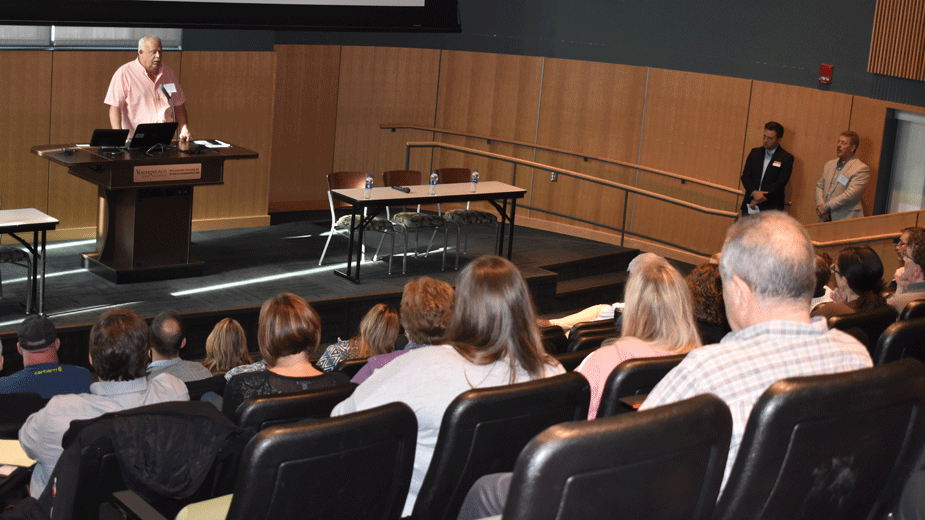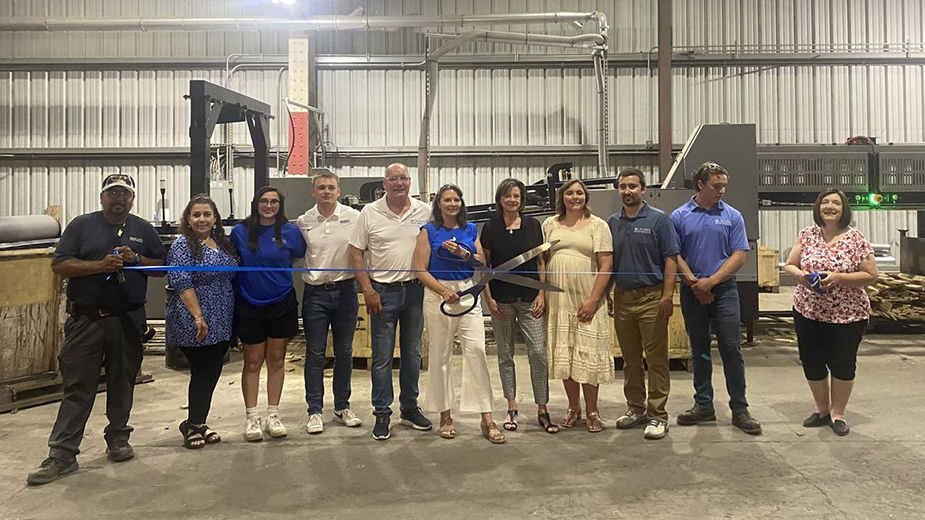Businesses Armed with Prevention at Active Shooter Conference
YOUNGSTOWN, Ohio – Most businesses don’t have a plan in place to address an active shooter incident, even though they are far more likely than other places to have such an incident occur.
Businesses are the No. 1 location for such incidents to occur, Micah Stoll, law enforcement training officer with the office of Ohio Attorney General Mike DeWine, said.
Stoll was among the presenters at the “It Didn’t Have to Happen” 2018 Active Shooter, School and Workplace Violence Conference. Presented by the Ohio Small Business Development Center at Youngstown State University, the conference took place at YSU’s Williamson Hall.
Although school shootings such as the massacre Feb. 14 at Marjorie Stoneman Douglas High School dominate the news cycle for days, if not weeks, shootings in workplaces occur about twice as often, according to a study by the Federal Bureau of Investigation, Stoll reported.
The FBI study of active shooter incidents between 2000 and 2015 found that 43.2% of the 220 incidents occurred in places of commerce. That includes 56 at businesses open to pedestrian traffic, 29 at businesses closed to pedestrian traffic and 10 at malls.
Educational environments were identified as having the next highest risk of such incidents, with 21.8%, or 48, taking place during that period.
The problem with businesses, Stoll said, “is the lack of a plan. Businesses need to have in place a “standardized yet flexible plan.”
Stoll advises businesses, schools and churches to go through five steps in the process:
- Put together a development team.
- Conduct a vulnerability assessment.
- Assess response capabilities.
- Review any plan in place.
- Create the emergency plan.
The plan needs to be specific for that business, he said. A plan for a company in urban Youngstown is going to be “completely different” from one in a more rural area.
Those attending the conference heard from law enforcement professionals, safety and security experts, vendors of security products and the survivor of a local active shooting.
“People say it never happens around here. Well, it did. I’m here to tell you, 27 years ago in June,” William John Everett said.
In 1991, Everett, then employed at Veterinary Companies of America in Warren, was shot three times when a former co-worker – who was terminated — returned armed with a revolver and killed two other workers.
Since the shooting at Columbine High School in April 1999, which left 13 people dead, “We’ve continued to bear witness to an increased frequency of active shooters, not just in schools but in soft targets such as churches, workplaces, venues such as a Waffle House, the Las Vegas Strip,” Bill Barna, president of Bolo Stick LLC, Warren, said.
“This is happening all the time,” he continued. “We need to consider what steps are we going to take, or do we walk through life thinking it could never happen here.”
About five years ago, Barna, who has been in law enforcement 31 years, was speaking as an active shooter instructor and learned from educators that in many cases they had to go outside their classrooms to lock them, potentially putting them in danger in an active shooter situation. That led him to develop the Bolo Stick, a device that can be inserted into a door from the inside of the classroom to immobilize it.
“It’s really not so much about if. It’s about when,” Barna said. “This stuff happens. It’s not just in Parkland. It’s not just in Sandy Hook.”
Since Columbine, 217 school shootings have occurred, including five since Parkland in February and 12 so far this year, said Travis Thompson, director of risk management for Hylant Group, a Toledo company whose services include risk management. The average is 10 per year.
“We aren’t even though April yet,” he said.
Students are becoming more educated about how to respond to such situations using “run, hide, fight” protocols than they are about math and other school subjects, a fact that both impresses and horrifies him, Thompson said.
While much of the debate has centered on the type of firearms used, Thompson noted that the average distance between a shooter and a victim is 24 inches.
“At 24 inches, you don’t need practice. You don’t need aim,” he said.
The objective for people who want to survive these situations is to put as much distance and as many barriers as possible between the shooter and the intended victim. In the shooting at Virginia Tech in 2007, a simple locked door was enough to deter the gunman from one classroom, allowing those inside to survive the massacre, which claimed 33 lives.
“We have to learn those things we can do to protect ourselves in any building we’re in,” he said. “There are things we can do to actively participate in our own safety with the things that we have on hand.”
In many schools, he pointed out, classroom and office doors are left unlocked and open. Businesses also often have similar vulnerabilities.
“If you have an office door, close and lock it if you can. If you can’t, close and lock the next available door that leads form a common place. Set up a series of barriers, working from point of contact out, not outside in” Thompson said. He also advised making sure any confrontation with a person intending to do harm take place on the other side of such barriers, via intercom.
The training needed for all front-desk employees can best be summed up by the movie “Roadhouse,” which Thompson called his “favorite movie ever for customer service.” In the film, Patrick Swayze plays a bouncer and cooler whose advice to his employees is “to be nice until it’s time not to be nice.”
One approach taken is to train people to consider themselves as first responders rather than law enforcement personnel and medical personnel.
“If someone comes around this ramp right now with a gun, a baseball bat or a crowbar, who are the first responders? We are. We have to start thinking that way,” said Tim Dimoff, president and CEO of SACS Consulting & Investigative Services Inc.
At Columbine, lives were lost because students were trained wrong, he said.
“We taught them to hide underneath the table, wait there, the police will come get you. What happened? Most of the kids got shot less than six inches from their head. They were executed,” he said. “The reason they were executed is because we taught them to get into a position that allowed them to get executed.”
More needs to be done to identify and intervene early, Dimoff urged. From reviewing nearly 400 active shooters, one common denominator he discovered is they often signal their intentions.
“We’ve got 95% of the shooters telling people – friends, students, co-workers, parents what they’re feeling and what they want to do and how they’re going to do it,” he said.
Dimoff called for the media to “deglamorize” perpetrators of mass shootings, who often receive 24/7 media coverage in the aftermath. “It becomes the medicine for the deranged, the psychotic, the mentally upset,” he said. In many cases, those inspired aim beat the “record” set by the last shooter.
Addressing the topic of arming school personnel, Dimoff said such measures often provide a relatively low-cost option for rural districts or other areas that don’t have the tax base to support other precautions, such as school resource officers.
One of the fastest growing client areas is churches, whose parishioners are increasingly calling on them to provide security, with some pastors even being armed during services, he said.
Among those attending Friday’s program was a group representing the City Church in Geneva. Douglas Dean, one of the church’s greeting team, said several parishioners have asked whether the church had anything in place for security.
“We want to make it a safe place,” he said.
Since the church meets in Geneva High School, it has to deal with protecting the members of the church while making sure any measures comply with the state requirements for being in a school, he said.
“It’s been very interesting to hear the different speakers and what they’ve experienced, and different ways of handing threats,” Dean said.
Linsey Gray, human resource manager at Anderson-Dubose Inc., Lordstown, said her company has been investigating resources to prepare for an active shooter or workplace violence scenario. The company already has done training with police departments and consulted with various companies about what kind of training makes the most sense. She attended the conference to research the best approach for the company.
“If nothing else, it’s making us realize that we do need to really dig in and possibly buy some things that will help our staff to protect themselves,” Gray said.
Pictured at top: “People say it never happens around here. Well, it did. I’m here to tell you, 27 years ago in June,” William John Everett said.
Copyright 2024 The Business Journal, Youngstown, Ohio.



